Abstract
Natural killer (NK) cells are inhibited from killing cellular targets by major histocompatibility complex (MHC) class I molecules. In the mouse, this can be mediated by the Ly-49A NK cell receptor that specifically binds the H-2Dd MHC class I molecule, then inhibits NK cell activity. Previous experiments have indicated that Ly-49A recognizes the alpha 1/alpha 2 domains of MHC class I and that no specific MHC-bound peptide appeared to be involved. We demonstrate here that alanine-substituted peptides, having only the minimal anchor motifs, stabilized H-2Dd expression and provided resistance to H-2Dd-transfected, transporter associated with processing (TAP)-deficient cells from lysis by Ly-49A+ NK cells. Peptide-induced resistance was blocked only by an mAb that binds a conformational determinant on H-2Dd. Moreover, stabilization of "empty" H-2Dd heavy chains by exogenous beta 2-microglobulin did not confer resistance. In contrast to data for MHC class I-restricted T cells that are specific for peptides displayed MHC molecules, these data indicate that NK cells are specific for a peptide-induced conformational determinant, independent of specific peptide. This fundamental distinction between NK cells and T cells further implies that NK cells are sensitive only to global changes in MHC class I conformation or expression, rather than to specific pathogen-encoded peptides. This is consistent with the "missing self" hypothesis, which postulates that NK cells survey tissues for normal expression of MHC class I.
Full text
PDF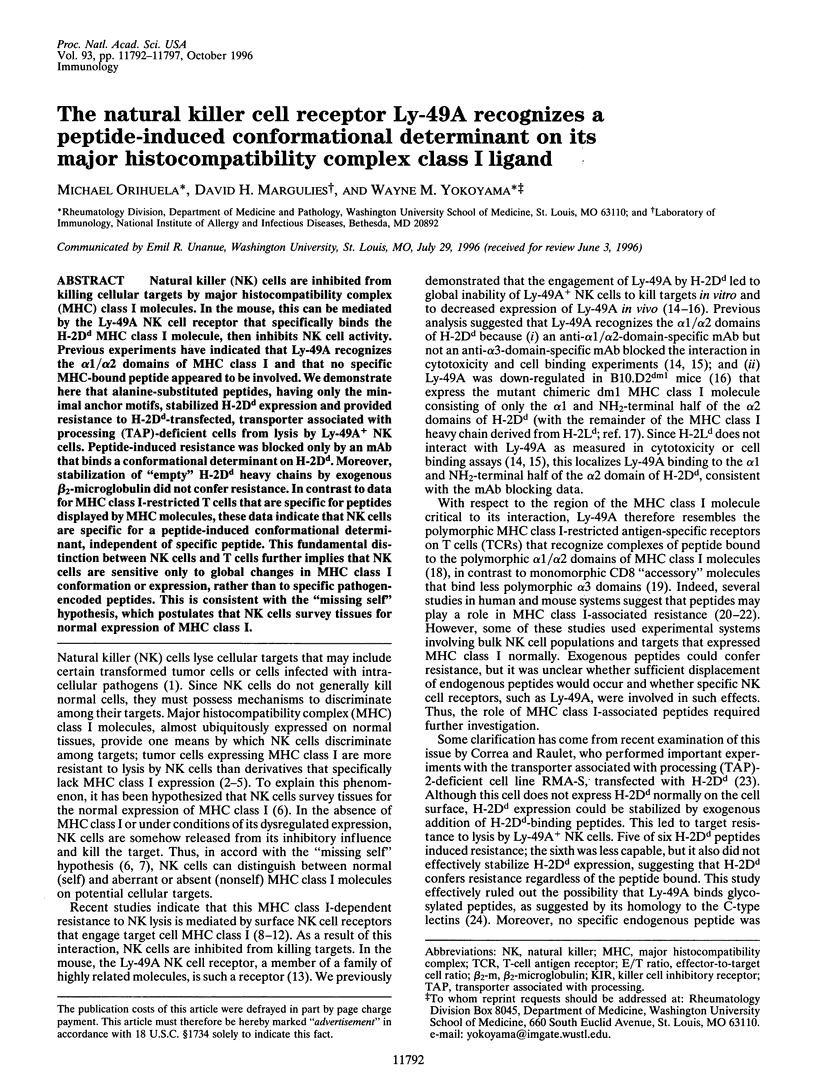
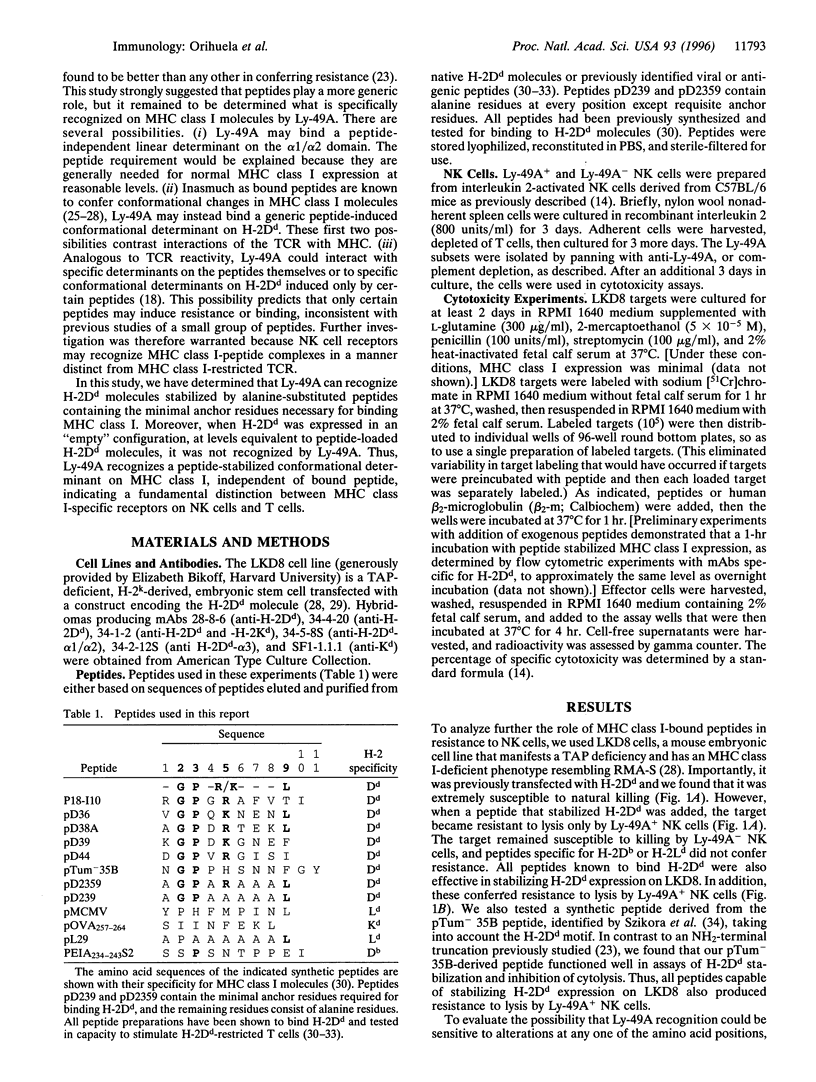
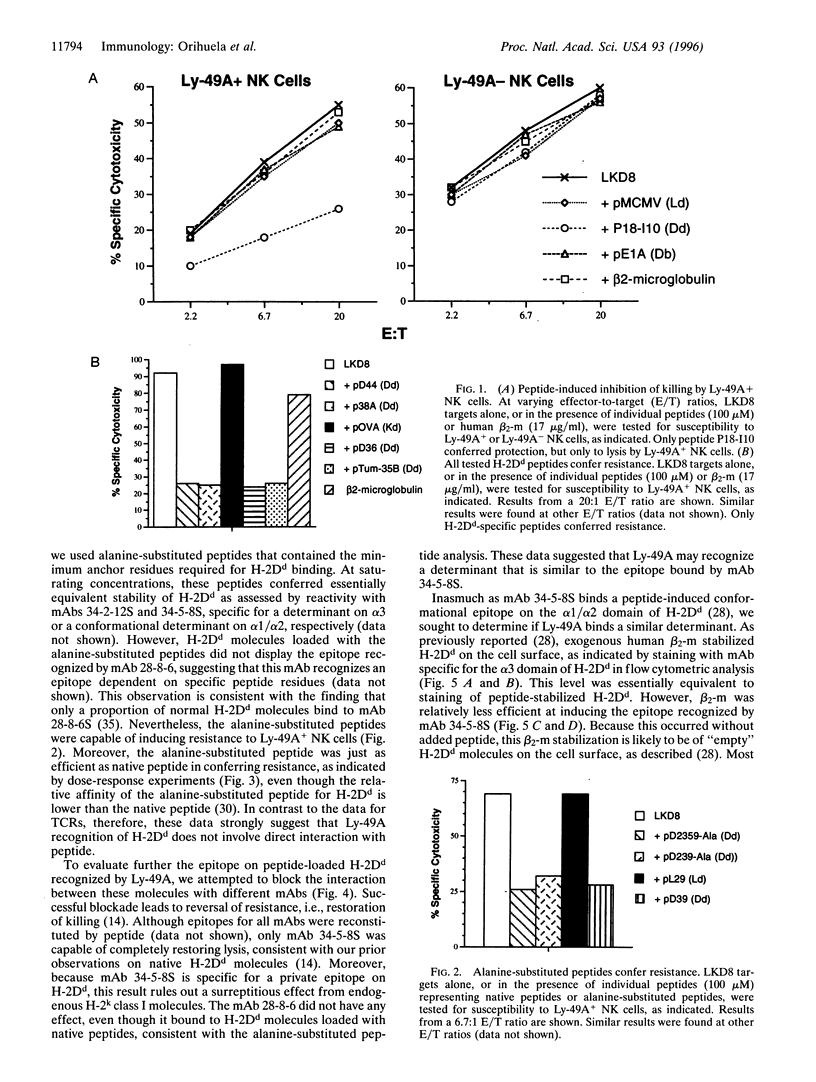
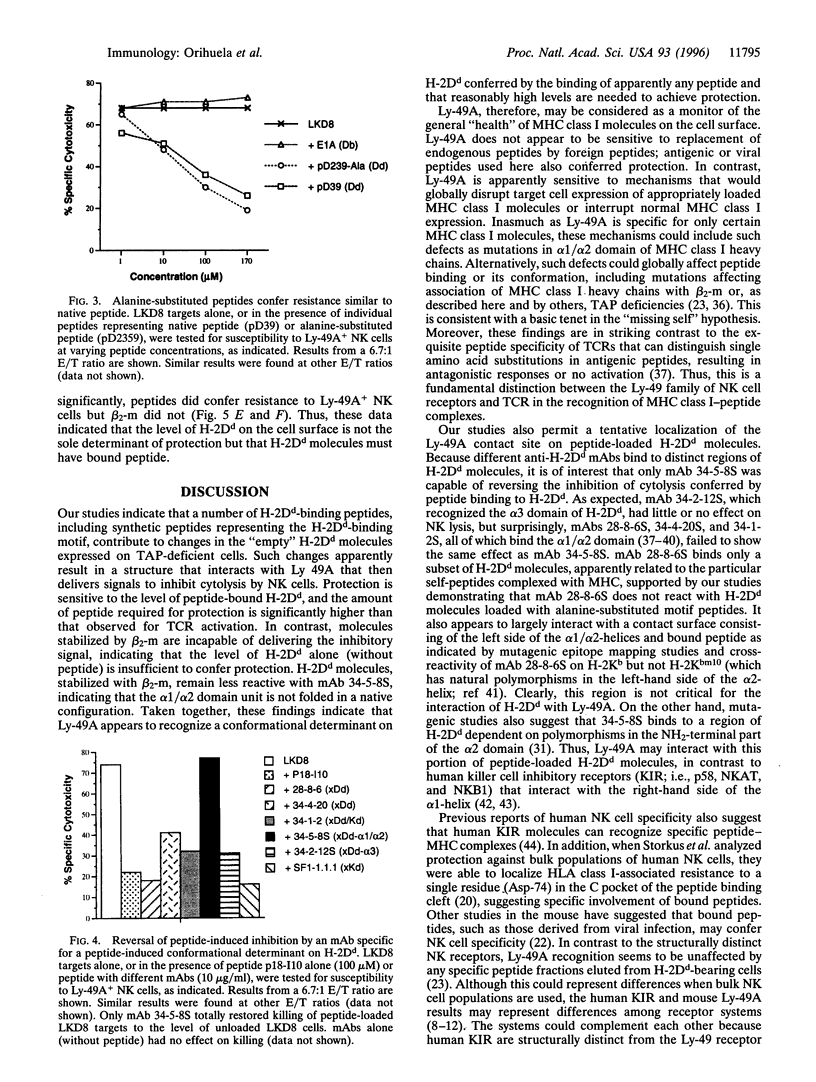
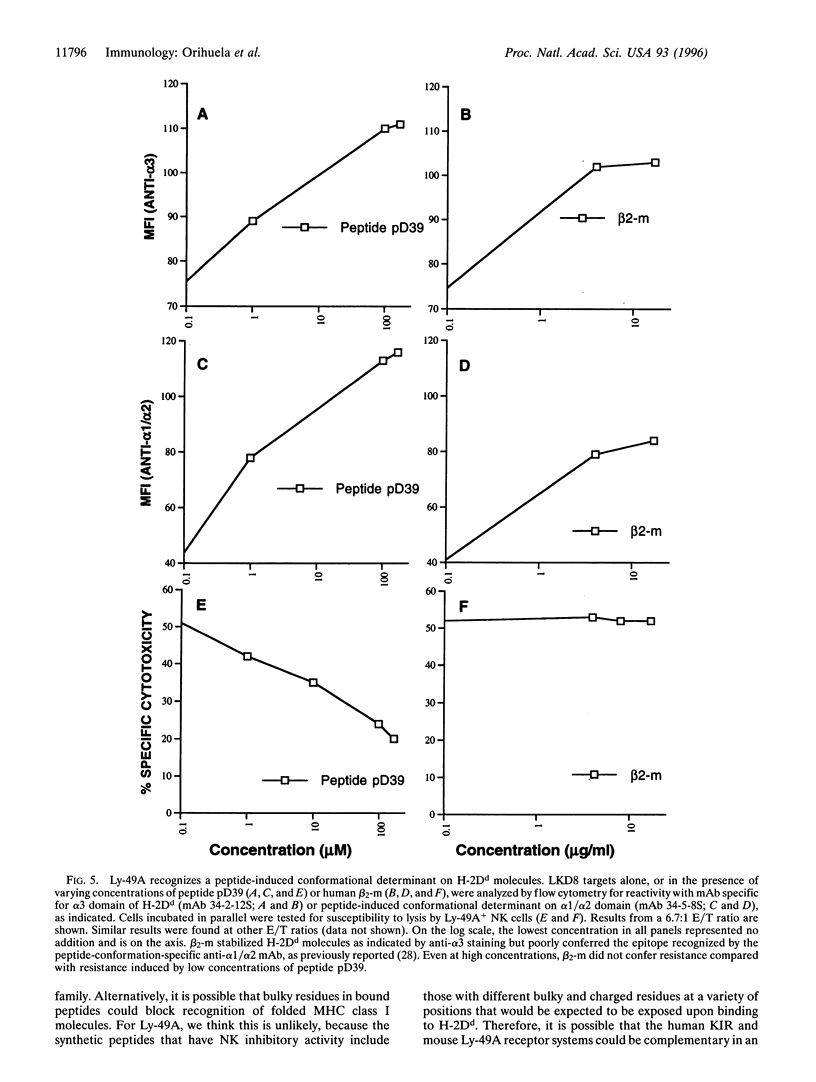
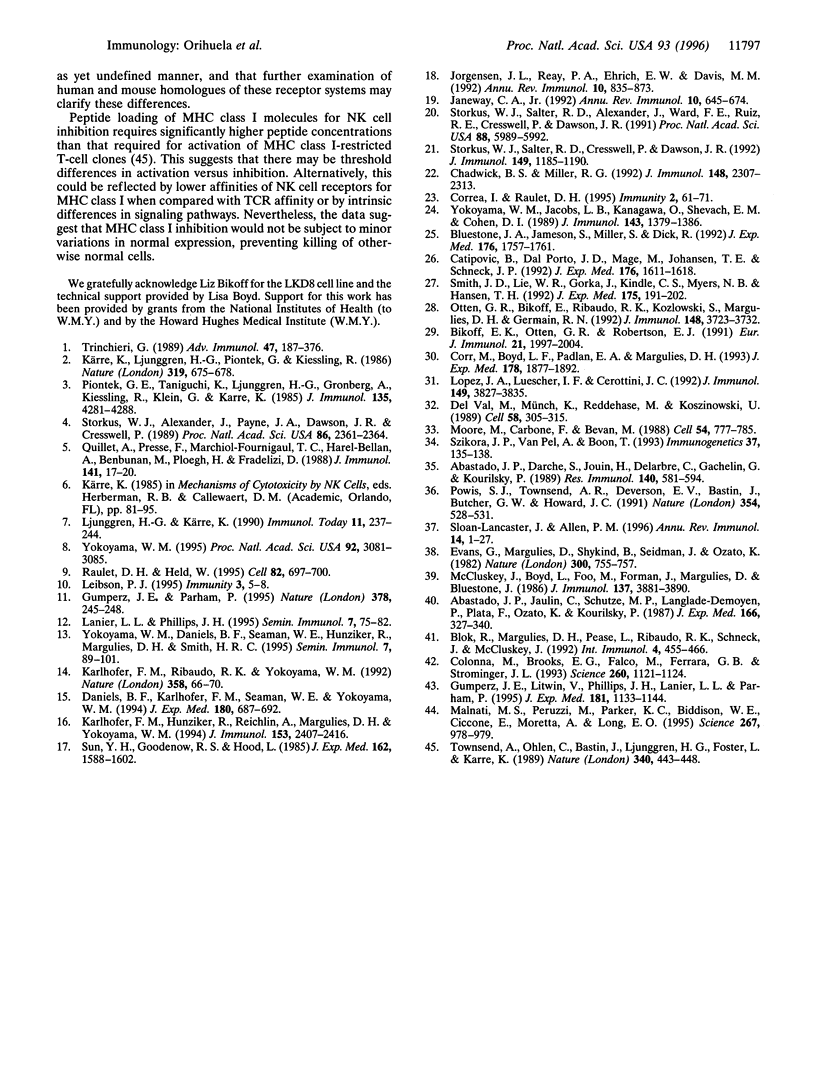
Images in this article
Selected References
These references are in PubMed. This may not be the complete list of references from this article.
- Abastado J. P., Darche S., Jouin H., Delarbre C., Gachelin G., Kourilsky P. A monoclonal antibody recognizes a subset of the H-2Dd mouse major class I antigens. Res Immunol. 1989 Jun-Aug;140(5-6):581–594. doi: 10.1016/0923-2494(89)90121-1. [DOI] [PubMed] [Google Scholar]
- Abastado J. P., Jaulin C., Schutze M. P., Langlade-Demoyen P., Plata F., Ozato K., Kourilsky P. Fine mapping of epitopes by intradomain Kd/Dd recombinants. J Exp Med. 1987 Aug 1;166(2):327–340. doi: 10.1084/jem.166.2.327. [DOI] [PMC free article] [PubMed] [Google Scholar]
- Bikoff E. K., Otten G. R., Robertson E. J. Defective assembly of class I major histocompatibility complex molecules in an embryonic cell line. Eur J Immunol. 1991 Sep;21(9):1997–2004. doi: 10.1002/eji.1830210905. [DOI] [PubMed] [Google Scholar]
- Blok R., Margulies D. H., Pease L., Ribaudo R. K., Schneck J., McCluskey J. CD8 expression alters the fine specificity of an alloreactive MHC class I-specific T hybridoma. Int Immunol. 1992 Apr;4(4):455–466. doi: 10.1093/intimm/4.4.455. [DOI] [PubMed] [Google Scholar]
- Bluestone J. A., Jameson S., Miller S., Dick R., 2nd Peptide-induced conformational changes in class I heavy chains alter major histocompatibility complex recognition. J Exp Med. 1992 Dec 1;176(6):1757–1761. doi: 10.1084/jem.176.6.1757. [DOI] [PMC free article] [PubMed] [Google Scholar]
- Catipović B., Dal Porto J., Mage M., Johansen T. E., Schneck J. P. Major histocompatibility complex conformational epitopes are peptide specific. J Exp Med. 1992 Dec 1;176(6):1611–1618. doi: 10.1084/jem.176.6.1611. [DOI] [PMC free article] [PubMed] [Google Scholar]
- Chadwick B. S., Miller R. G. Hybrid resistance in vitro. Possible role of both class I MHC and self peptides in determining the level of target cell sensitivity. J Immunol. 1992 Apr 1;148(7):2307–2313. [PubMed] [Google Scholar]
- Colonna M., Brooks E. G., Falco M., Ferrara G. B., Strominger J. L. Generation of allospecific natural killer cells by stimulation across a polymorphism of HLA-C. Science. 1993 May 21;260(5111):1121–1124. doi: 10.1126/science.8493555. [DOI] [PubMed] [Google Scholar]
- Corr M., Boyd L. F., Padlan E. A., Margulies D. H. H-2Dd exploits a four residue peptide binding motif. J Exp Med. 1993 Dec 1;178(6):1877–1892. doi: 10.1084/jem.178.6.1877. [DOI] [PMC free article] [PubMed] [Google Scholar]
- Correa I., Raulet D. H. Binding of diverse peptides to MHC class I molecules inhibits target cell lysis by activated natural killer cells. Immunity. 1995 Jan;2(1):61–71. doi: 10.1016/1074-7613(95)90079-9. [DOI] [PubMed] [Google Scholar]
- Daniels B. F., Karlhofer F. M., Seaman W. E., Yokoyama W. M. A natural killer cell receptor specific for a major histocompatibility complex class I molecule. J Exp Med. 1994 Aug 1;180(2):687–692. doi: 10.1084/jem.180.2.687. [DOI] [PMC free article] [PubMed] [Google Scholar]
- Del Val M., Münch K., Reddehase M. J., Koszinowski U. H. Presentation of CMV immediate-early antigen to cytolytic T lymphocytes is selectively prevented by viral genes expressed in the early phase. Cell. 1989 Jul 28;58(2):305–315. doi: 10.1016/0092-8674(89)90845-3. [DOI] [PubMed] [Google Scholar]
- Evans G. A., Margulies D. H., Shykind B., Seidman J. G., Ozato K. Exon shuffling: mapping polymorphic determinants on hybrid mouse transplantation antigens. Nature. 1982 Dec 23;300(5894):755–757. doi: 10.1038/300755a0. [DOI] [PubMed] [Google Scholar]
- Gumperz J. E., Litwin V., Phillips J. H., Lanier L. L., Parham P. The Bw4 public epitope of HLA-B molecules confers reactivity with natural killer cell clones that express NKB1, a putative HLA receptor. J Exp Med. 1995 Mar 1;181(3):1133–1144. doi: 10.1084/jem.181.3.1133. [DOI] [PMC free article] [PubMed] [Google Scholar]
- Gumperz J. E., Parham P. The enigma of the natural killer cell. Nature. 1995 Nov 16;378(6554):245–248. doi: 10.1038/378245a0. [DOI] [PubMed] [Google Scholar]
- Janeway C. A., Jr The T cell receptor as a multicomponent signalling machine: CD4/CD8 coreceptors and CD45 in T cell activation. Annu Rev Immunol. 1992;10:645–674. doi: 10.1146/annurev.iy.10.040192.003241. [DOI] [PubMed] [Google Scholar]
- Jorgensen J. L., Reay P. A., Ehrich E. W., Davis M. M. Molecular components of T-cell recognition. Annu Rev Immunol. 1992;10:835–873. doi: 10.1146/annurev.iy.10.040192.004155. [DOI] [PubMed] [Google Scholar]
- Karlhofer F. M., Hunziker R., Reichlin A., Margulies D. H., Yokoyama W. M. Host MHC class I molecules modulate in vivo expression of a NK cell receptor. J Immunol. 1994 Sep 15;153(6):2407–2416. [PubMed] [Google Scholar]
- Karlhofer F. M., Ribaudo R. K., Yokoyama W. M. MHC class I alloantigen specificity of Ly-49+ IL-2-activated natural killer cells. Nature. 1992 Jul 2;358(6381):66–70. doi: 10.1038/358066a0. [DOI] [PubMed] [Google Scholar]
- Kärre K. Express yourself or die: peptides, MHC molecules, and NK cells. Science. 1995 Feb 17;267(5200):978–979. doi: 10.1126/science.7863341. [DOI] [PubMed] [Google Scholar]
- Kärre K., Ljunggren H. G., Piontek G., Kiessling R. Selective rejection of H-2-deficient lymphoma variants suggests alternative immune defence strategy. Nature. 1986 Feb 20;319(6055):675–678. doi: 10.1038/319675a0. [DOI] [PubMed] [Google Scholar]
- Lanier L. L., Phillips J. H. NK cell recognition of major histocompatibility complex class I molecules. Semin Immunol. 1995 Apr;7(2):75–82. doi: 10.1006/smim.1995.0011. [DOI] [PubMed] [Google Scholar]
- Leibson P. J. MHC-recognizing receptors: they're not just for T cells anymore. Immunity. 1995 Jul;3(1):5–8. doi: 10.1016/1074-7613(95)90153-1. [DOI] [PubMed] [Google Scholar]
- Ljunggren H. G., Kärre K. In search of the 'missing self': MHC molecules and NK cell recognition. Immunol Today. 1990 Jul;11(7):237–244. doi: 10.1016/0167-5699(90)90097-s. [DOI] [PubMed] [Google Scholar]
- López J. A., Luescher I. F., Cerottini J. C. Direct binding of peptides to MHC class I molecules on living cells. Analysis at the single cell level. J Immunol. 1992 Dec 15;149(12):3827–3835. [PubMed] [Google Scholar]
- McCluskey J., Boyd L., Foo M., Forman J., Margulies D. H., Bluestone J. A. Analysis of hybrid H-2D and L antigens with reciprocally mismatched aminoterminal domains: functional T cell recognition requires preservation of fine structural determinants. J Immunol. 1986 Dec 15;137(12):3881–3890. [PubMed] [Google Scholar]
- Moore M. W., Carbone F. R., Bevan M. J. Introduction of soluble protein into the class I pathway of antigen processing and presentation. Cell. 1988 Sep 9;54(6):777–785. doi: 10.1016/s0092-8674(88)91043-4. [DOI] [PubMed] [Google Scholar]
- Otten G. R., Bikoff E., Ribaudo R. K., Kozlowski S., Margulies D. H., Germain R. N. Peptide and beta 2-microglobulin regulation of cell surface MHC class I conformation and expression. J Immunol. 1992 Jun 15;148(12):3723–3732. [PubMed] [Google Scholar]
- Piontek G. E., Taniguchi K., Ljunggren H. G., Grönberg A., Kiessling R., Klein G., Kärre K. YAC-1 MHC class I variants reveal an association between decreased NK sensitivity and increased H-2 expression after interferon treatment or in vivo passage. J Immunol. 1985 Dec;135(6):4281–4288. [PubMed] [Google Scholar]
- Powis S. J., Townsend A. R., Deverson E. V., Bastin J., Butcher G. W., Howard J. C. Restoration of antigen presentation to the mutant cell line RMA-S by an MHC-linked transporter. Nature. 1991 Dec 19;354(6354):528–531. doi: 10.1038/354528a0. [DOI] [PubMed] [Google Scholar]
- Quillet A., Presse F., Marchiol-Fournigault C., Harel-Bellan A., Benbunan M., Ploegh H., Fradelizi D. Increased resistance to non-MHC-restricted cytotoxicity related to HLA A, B expression. Direct demonstration using beta 2-microglobulin-transfected Daudi cells. J Immunol. 1988 Jul 1;141(1):17–20. [PubMed] [Google Scholar]
- Raulet D. H., Held W. Natural killer cell receptors: the offs and ons of NK cell recognition. Cell. 1995 Sep 8;82(5):697–700. doi: 10.1016/0092-8674(95)90466-2. [DOI] [PubMed] [Google Scholar]
- Sloan-Lancaster J., Allen P. M. Altered peptide ligand-induced partial T cell activation: molecular mechanisms and role in T cell biology. Annu Rev Immunol. 1996;14:1–27. doi: 10.1146/annurev.immunol.14.1.1. [DOI] [PubMed] [Google Scholar]
- Smith J. D., Lie W. R., Gorka J., Kindle C. S., Myers N. B., Hansen T. H. Disparate interaction of peptide ligand with nascent versus mature class I major histocompatibility complex molecules: comparisons of peptide binding to alternative forms of Ld in cell lysates and the cell surface. J Exp Med. 1992 Jan 1;175(1):191–202. doi: 10.1084/jem.175.1.191. [DOI] [PMC free article] [PubMed] [Google Scholar]
- Storkus W. J., Alexander J., Payne J. A., Dawson J. R., Cresswell P. Reversal of natural killing susceptibility in target cells expressing transfected class I HLA genes. Proc Natl Acad Sci U S A. 1989 Apr;86(7):2361–2364. doi: 10.1073/pnas.86.7.2361. [DOI] [PMC free article] [PubMed] [Google Scholar]
- Storkus W. J., Salter R. D., Alexander J., Ward F. E., Ruiz R. E., Cresswell P., Dawson J. R. Class I-induced resistance to natural killing: identification of nonpermissive residues in HLA-A2. Proc Natl Acad Sci U S A. 1991 Jul 15;88(14):5989–5992. doi: 10.1073/pnas.88.14.5989. [DOI] [PMC free article] [PubMed] [Google Scholar]
- Storkus W. J., Salter R. D., Cresswell P., Dawson J. R. Peptide-induced modulation of target cell sensitivity to natural killing. J Immunol. 1992 Aug 15;149(4):1185–1190. [PubMed] [Google Scholar]
- Sun Y. H., Goodenow R. S., Hood L. Molecular basis of the dm1 mutation in the major histocompatibility complex of the mouse: a D/L hybrid gene. J Exp Med. 1985 Nov 1;162(5):1588–1602. doi: 10.1084/jem.162.5.1588. [DOI] [PMC free article] [PubMed] [Google Scholar]
- Szikora J. P., Van Pel A., Boon T. Tum- mutation P35B generates the MHC-binding site of a new antigenic peptide. Immunogenetics. 1993;37(2):135–138. doi: 10.1007/BF00216837. [DOI] [PubMed] [Google Scholar]
- Townsend A., Ohlén C., Bastin J., Ljunggren H. G., Foster L., Kärre K. Association of class I major histocompatibility heavy and light chains induced by viral peptides. Nature. 1989 Aug 10;340(6233):443–448. doi: 10.1038/340443a0. [DOI] [PubMed] [Google Scholar]
- Trinchieri G. Biology of natural killer cells. Adv Immunol. 1989;47:187–376. doi: 10.1016/S0065-2776(08)60664-1. [DOI] [PMC free article] [PubMed] [Google Scholar]
- Yokoyama W. M., Daniels B. F., Seaman W. E., Hunziker R., Margulies D. H., Smith H. R. A family of murine NK cell receptors specific for target cell MHC class I molecules. Semin Immunol. 1995 Apr;7(2):89–101. doi: 10.1006/smim.1995.0013. [DOI] [PubMed] [Google Scholar]
- Yokoyama W. M., Jacobs L. B., Kanagawa O., Shevach E. M., Cohen D. I. A murine T lymphocyte antigen belongs to a supergene family of type II integral membrane proteins. J Immunol. 1989 Aug 15;143(4):1379–1386. [PubMed] [Google Scholar]
- Yokoyama W. M. Natural killer cell receptors specific for major histocompatibility complex class I molecules. Proc Natl Acad Sci U S A. 1995 Apr 11;92(8):3081–3085. doi: 10.1073/pnas.92.8.3081. [DOI] [PMC free article] [PubMed] [Google Scholar]



